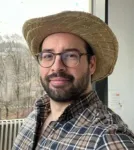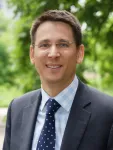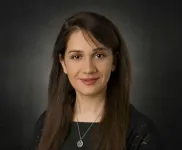(Press-News.org) In a world overrun by petroleum-based plastics, scientists are searching for alternatives that are more sustainable, more biodegradable and far less toxic to the environment.
Two new studies by biologists at Washington University in St. Louis highlight one potential source of game-changing materials: purple bacteria that, with a little encouragement, can act like microscopic factories for bioplastics.
A study led by graduate student Eric Conners found that two relatively obscure species of purple bacteria have the ability to produce polyhydroxyalkanoates (PHAs), natural polymers that can be purified to make plastic.
Another study led by research lab supervisor Tahina Ranaivoarisoa showed that genetic engineering could coax a well-studied but notoriously stubborn species of purple bacteria to dramatically ramp up its production of PHAs.
Conners and Ranaivoarisoa work in the lab of Arpita Bose, an associate professor of biology in Arts & Sciences and corresponding author of the new studies. “There’s a huge global demand for bioplastics,” Bose said. “They can be produced without adding CO2 to the atmosphere and are completely biodegradable. These two studies show the importance of taking multiple approaches to finding new ways to produce this valuable material.”
Purple bacteria are a special group of aquatic microbes renowned for their adaptability and ability to create useful compounds from simple ingredients. Like green plants and some other bacteria, they can turn carbon dioxide into food using energy from the sun. But instead of green chlorophyll, they use other pigments to capture sunlight.
The bacteria naturally produce PHAs and other building blocks of bioplastics to store extra carbon. Under the right conditions, they can keep producing those polymers indefinitely.
As the WashU biologists report this week in Microbial Biotechnology, two little-known species of purple bacteria in the genus Rhodomicrobium showed a remarkable willingness to produce polymers, especially when energized with small amounts of electricity and nourished with nitrogen. “It’s worth taking a look at bacteria that we haven’t looked at before,” Conners said. “We haven’t come close to realizing their potential.”
Rhodomicrobium bacteria have unusual properties that make them intriguing contenders as natural bioplastic factories. “It’s a unique bacteria that looks very different from other purple bacteria,” Conners said. While some species float around cultures as individual cells, this particular genus forms interconnected networks that seem especially well-equipped to produce PHA.
Other types of bacteria can also produce bioplastic polymers with some help. As reported in Applied and Environmental Microbiology, the WashU researchers used genetic engineering to coax impressive levels of PHAs out of Rhodopseudomonas palustris TIE-1, a well-studied species typically reluctant to produce the polymers. “TIE-1 is a great organism to study, but it’s historically not been the best for producing PHA,” Ranaivoarisoa said.
Several genetic tweaks helped boost the output of PHA, but one approach was especially successful. Researchers saw impressive results when they inserted a gene that increased the natural enzyme RuBisCO, the catalyst that helps plants and bacteria capture carbon from air and water. With the help of the super-charged enzyme, the usually sluggish bacteria turned into relative PHA powerhouses. The researchers are optimistic a similar approach could be possible with other bacteria that might be able to produce even higher levels of bioplastics.
In the near future, Bose plans to take a closer look at the quality and possible uses of the polymers produced in her lab. “We hope these bioplastics will produce real solutions down the road.”
Originally published on The Ampersand website
END
Turning bacteria into bioplastic factories
2024-08-23
ELSE PRESS RELEASES FROM THIS DATE:
Researcher finds sound progress in babies’ speech development
2024-08-23
The sounds babies make in their first year of life may be less random than previously believed, according to a language development researcher from The University of Texas at Dallas.
Dr. Pumpki Lei Su, an assistant professor of speech, language, and hearing in the School of Behavioral and Brain Sciences, is co-lead author on two recent articles in which researchers examined the sounds babies make. The results suggest that children in their first year are more active than previously thought in their acquisition of speech.
“We observed in these studies that infant vocalizations are not produced randomly; they form a pattern, producing three categories of sounds in clusters,” ...
Two epicenters led to Japan’s violent Noto earthquake on New Year's Day
2024-08-23
Key takeaways
The 7.5- magnitude earthquake beneath Japan’s Noto Peninsula on Jan. 1, 2024, occurred when a “dual-initiation mechanism” applied enough energy from two different locations to break through a fault barrier – an area that locks two sides of a fault in place and absorbs the energy of fault movement, slowing it down or stopping it altogether.
An international team of researchers led by UCLA graduate student Liuwei Xu, professor Lingsen Meng and UC Santa Barbara’s Chen Ji analyzed a preceding seismic swarm and identified a previously unknown barrier in the region of the swarm.
The team’s data collection methods could ...
A leaky sink: Carbon emissions from forest soil will likely grow with rising temperatures
2024-08-23
Photos
The soils of northern forests are key reservoirs that help keep the carbon dioxide that trees inhale and use for photosynthesis from making it back into the atmosphere.
But a unique experiment led by Peter Reich of the University of Michigan is showing that, on a warming planet, more carbon is escaping the soil than is being added by plants.
"This is not good news because it suggests that, as the world warms, soils are going to give back some of their carbon to the atmosphere," said Reich, director of the Institute for Global Change ...
Rice bioengineers develop lotus leaf-inspired system to advance study of cancer cell clusters
2024-08-23
HOUSTON – (Aug. 23, 2024) – The lotus leaf is a pioneer of self-cleaning, water-repellant engineering. Water droplets all but hover on its surface, whose unique texture traps air in its nanosized ridges and folds.
Rice University bioengineers report harnessing the lotus effect to develop a system for culturing cancer cell clusters that can shed light on hard-to-study tumor properties. The new zinc oxide-based culturing surface mimics the lotus leaf surface structure, providing a highly tunable platform for the high-throughput generation of three-dimensional nanoscale tumor models.
The superhydrophobic array device (SHArD) designed by Rice bioengineer Michael King and ...
To mask or not to mask: That is still the question
2024-08-23
CHICAGO --- Despite the association between mask mandates/mask wearing and reduced death rates during the pandemic, masking remains controversial and highly politicized, with many people still asking, “do masks work, and should they be recommended?”
In an editorial about the use of surgical face masks in public, published today, Aug. 23, in The BMJ, Northwestern Medicine internal medicine experts Drs. Jeffrey Linder and Rachel Amdur make the case for masking but acknowledge it’s not a cut-and-dried topic.
The ...
A switch for immune memory and anti-tumor immunity
2024-08-23
AUGUST 23, 2024, NEW YORK – A Ludwig Cancer Research study has identified a metabolic switch in the immune system’s T cells that is essential to the generation of memory T cells—which confer lasting immunity to previously encountered pathogens—and a T cell subtype found in tumors that drives anti-tumor responses during immunotherapy.
Led by Ludwig Lausanne’s Ping-Chih Ho and Alessio Bevilacqua and published in the current issue of Science Immunology, the study identifies PPARβ/δ, a master regulator of gene expression, as that essential molecular switch. Ho, Bevilacqua and their colleagues also show that the switch’s dysfunction compromises ...
Study finds nearly half of U.S. counties have at least one ‘pharmacy desert’
2024-08-23
COLUMBUS, Ohio – Nearly half of counties in the United States have at least one ‘pharmacy desert’ where there is no retail pharmacy within 10 miles, according to a new study published by researchers at The Ohio State University Comprehensive Cancer Center – Arthur G. James Cancer Hospital and Richard J. Solove Research Institute (OSUCCC – James).
“As pharmacies close, more and more Americans are left without easy access to medications, with disproportionate consequences on certain communities. We found that patients in counties with higher social vulnerabilities and fewer primary care providers were up to 40% more likely to reside in a region ...
MSU study finds placebos reduce stress, anxiety, depression — even when people know they are placebos
2024-08-23
MSU has a satellite uplink/LTN TV studio and Comrex line for radio interviews upon request.
EAST LANSING, Mich. – A study out of Michigan State University found that nondeceptive placebos, or placebos given with people fully knowing they are placebos, effectively manage stress — even when the placebos are administered remotely.
Researchers recruited participants experiencing prolonged stress from the COVID-19 pandemic for a two-week randomized controlled trial. Half of the ...
MSU discovers method for CRISPR-based genome editing in Nile grass rats
2024-08-23
EAST LANSING, Mich. – A team of researchers at Michigan State University has discovered a set of methods that enabled the first successful CRISPR-based genome editing in Nile grass rats.
The study, published in BMC Biology, is the first to successfully edit genomes in Nile grass rats. As diurnal rodents, Nile grass rats have similar sleep/awake patterns to humans which could be advantageous in preclinical or translational research.
Currently, preclinical research relies heavily on laboratory mice, which are nocturnal rodents who are active at night and sleep during the day. With these different sleep patterns, diurnal and nocturnal ...
UVA engineering professors target inclusive AI education with $1 million grant
2024-08-23
Underserved high school students often lack access to artificial intelligence education that could prepare them for future careers in technology. Researchers at the University of Virginia School of Engineering and Applied Science and Clemson University are hoping to change that.
To help bridge the educational divide, the research team received a $1 million grant from the National Science Foundation to democratize access to AI education. Future fair and equitable technologies depend on a robust AI education, and expanding access to that education is crucial.
The project is part of the NSF’s Experiential Learning for ...





